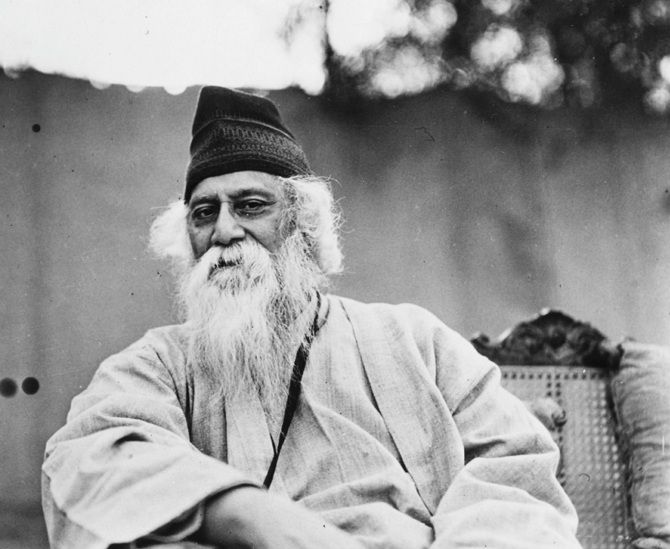Original Tagore paintings cordoned off by orange traffic cones.
Wall paper in gold and bronze and the lighting fit for a showroom in any mall.
Tacky rangoli on the floor.
Knowing Tagore's dedication to aesthetics and simplicity, Keya Sarkar wonders what he would have thought of the modern-day commemorations organised in his honour.

A couple of months ago we had some friends over for breakfast and I happened to mention to them that there was an opportunity to view Tagore's paintings in the original at an exhibition organised in Santiniketan.
Considering how rare it is to see Tagore's works in his own museums, my friends went straight from breakfast.
After about an hour one of them called, beside herself in anger. Apparently the paintings were cordoned off from visitors not by rope as is normal but by orange traffic cones.
Knowing Tagore's dedication to the highest of aesthetics, she was truly enraged.
I had strangely the same feeling when I went to visit a new gallery, which opened recently (only four years late) to commemorate 100 years of the publication of Tagore's Song Offerings, popularly known as the English Gitanjali, in the year 1912.
This in fact had got Tagore the Nobel, first for an Asian.
My heart sank the moment I entered. This looked like a jewellery showroom. The floor was marble and granite, the wall paper was antique gold and bronze and the lighting fit for a Titan showroom in any mall.
My stomach churned as I tried to imagine what Tagore, known for his simplicity, would have thought of this commemoration.
There was also rangoli or alpona on the floor in some strange wriggly design reminiscent of the plastic paste-on rangolis.
And this, in Santiniketan -- where the stalwarts of the Bengal art movement had made alpona into an ornamentation, which made any other unnecessary.
Reconciled to the decor (done apparently by some interior design firm from Kolkata) I decided to focus on the curation.
In the three rooms dedicated to this English edition of the Gitanjali there were only a lot of handwritten manuscripts pasted on the walls (much of it in Bengali).
They stretched almost up to the ceiling which made reading, even for the very interested, quite a task.
The curation was in a style similar to that of a student who didn't know the relevant answer in an examination and so puts down all he knows on the subject in the hope that the examiner will find the relevant lines somewhere.
There was no story, no anecdotes -- just a lot of written matter on the walls and a few glass cases with objects whose relationship with the Gitanjali was completely unexplained.
There were also some busts of Tagore by various eminent artists. But there was also one by a currently serving peon with the museum, who dabbled in sculpting.
The signage on a door which said 'exit' actually led me to one room with a mirror covering one wall, quite like a cheap motel. I thought maybe because of the mirror I was not able to locate the exit door, but the security man explained that was not the exit.
"So why the signage?" I asked.
"Everybody knows it's the other way," he explained.
The decor, the curation, the signage -- all that makes up a good museum had me intrigued. I climbed up one floor to meet an official if I could.
Found one and asked him why, when Tagore's whole life had been exhibited in just two rooms of the museum, a decision had been taken to devote so much space to only one publication -- the Gitanjali in English.
The gentleman said it was because an ex-Member of Parliament had made a donation from his LAD (local area development) fund to the museum and he had suggested this theme.
So poor Tagore got 'developed' and the MP got his pound's worth -- a large two feet by two feet plaque at the entrance which paid homage to his generosity.











